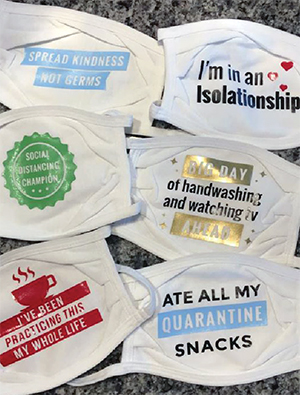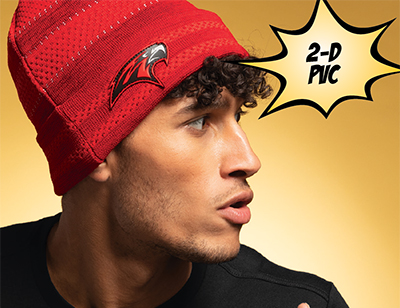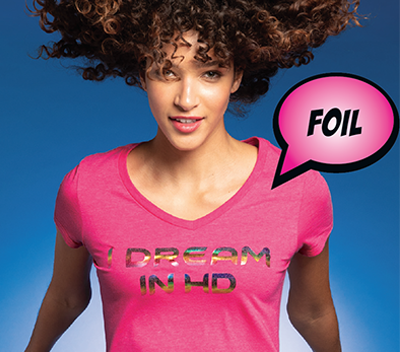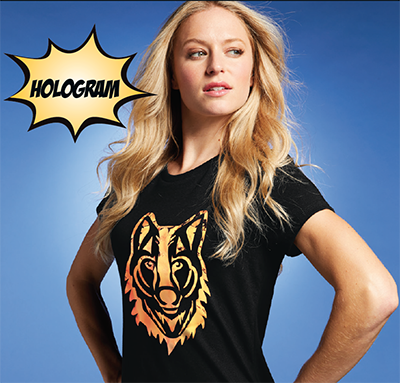Every market serviced by awards and personalization professionals experiences shifting trends, but few
see the kinds of ebbs and flows in preference that happen in the apparel and other wearables market. Whether it’s changes to popular colors or the emergence of a new clothing style, trends are always changing—and during few times has this been truer than in 2020. But not everything in apparel has been adjusted; plenty of timeless trends (and tips and tricks to consider when accommodating apparel orders) can still take you through this year and into the next. Here, we cover what has changed— and what has stayed solidly the same—for apparel and other wearables.
Apparel Update
How the Market Has Changed—and Stayed the Same—for Apparel and Other Wearables
by Danielle Leber
Every market serviced by awards and personalization professionals experiences shifting trends, but few
see the kinds of ebbs and flows in preference that happen in the apparel and other wearables market. Whether it’s changes to popular colors or the emergence of a new clothing style, trends are always changing—and during few times has this been truer than in 2020. But not everything in apparel has been adjusted; plenty of timeless trends (and tips and tricks to consider when accommodating apparel orders) can still take you through this year and into the next. Here, we cover what has changed— and what has stayed solidly the same—for apparel and other wearables.
MASK MANDATES

Photo courtesy of SanMar
Any article about apparel absolutely must address the most impactful change to this market in 2020: the sudden emergence of masks as an in-demand wearable.
Unlike the many apparel trends that preceded it—which primarily revolved around people’s preferences for certain colors, patterns, and textures—the sudden shift to masks because of COVID-19 presented unique personalization challenges many professionals had never faced before.
“The interesting part was figuring out how to decorate it,” said Jason Murphy, senior strategic account manager, decorator and digital solutions, for SanMar. “Because it covers your face, the question was, ‘What products can we use? What is safe?’”Some of the chemicals used in certain inks or personalization products may not be rated for use on something worn on the face, Murphy noted, and other traditional personalization methods—such as embroidery—created challenges when applied to products that were meant to both protect and be breathable.

Face covering logo placement options. Photo courtesy of SanMar.
Some of the chemicals used in certain inks or personalization products may not be rated for use on something worn on the face, Murphy noted, and other traditional personalization methods—such as embroidery—created challenges when applied to products that were meant to both protect and be breathable.
“If you’re embroidering it, you’re poking holes in it,” limiting its effectiveness, he said. “And placement is a consideration. You don’t want to embroider on the front of the mask because then you’re blocking all breathability. That was a huge project I was working on earlier in the year: sending out samples and talking to transfer manufacturers and embroidery equipment Any article about apparel absolutely must address the most impactful change to this."
According to Mark Merola, customer service team lead at Stahls’, there’s another consideration when creating cool masks for customers. “Decorating masks has its own set of challenges, so to speak, because they’re so small.”
That can make screen printing and other techniques difficult to accomplish, especially for apparel retailers, who have long considered how to accommodate larger and larger sizes—and orders—but not necessarily small-scale items.
However, suppliers have discovered a ton of tips and tricks to help you personalize even the most petite masks— including some innovative products that do all the personalization work for you.

Photo courtesy of SanMar.
Avon Lake, OH-based Catania Medallic Specialty, Inc., for example, has released a new line of “face mask bling” options that attach to masks using magnets or with rounded tip clip-on attachments, ensuring customers can swap out their mask decorations daily.
Retailers looking for additional assistance can also reach out directly to their equipment or substrate manufacturers—and many also have guides available, such as through SanMar U, the company’s online education resource, and Stahls’ “Help and Education” section on its website.
TRENDS AND TASTES
Masks aren’t the only wearables experiencing a boom in popularity under COVID-19 conditions. Other types of apparel also are experiencing a resurgence.
Although “athleisure” was already establishing its place in the apparel market before 2020, its recent boom can largely be credited to the sudden shifts in workplaces happening around the globe. As customers increasingly started working from home, preferences started trending toward more comfortable options that can still promote corporate culture with logos and other personalization.
“Back when everybody was going back into the office, the market was based around more corporate wear,” Murphy said. “Today, that corporate wear has changed—it’s become more of a hybrid kind of thing. Companies that are giving apparel to their workers are making those options more comfortable because they realize employees are sitting at home and everything needs to be for a crossover kind of wear.”

A corn-based PVC makes this fun decoration eco-friendly, and designed to make an impression. Photo courtesy of SanMar.
Even those employees working onsite— especially workers who may be subject to additional requirements in terms of their interactions with customers or fellow staff—are requesting different options for their apparel.
“People now want ‘safety’ options, like T-shirts in bright yellow colors, that send the message ‘stand back 6 feet,’” Merola said.
But even as clothing types change, some things simply never go out of style.
“I’ve noticed an uptick in requests for foils and blings again,” he said. “I looked at that and said, ‘This is because of the cheerleaders and dance teams.’ The country lost spring sports and a lot of spring sports and a lot of summer sports, but as we’re going into fall sports, it looked like things could be getting back to a little bit of normalcy.”


Hologram and foil designs: Shiny, translucent vinyl decoration ideal for logos and personalization. Photos courtesy of SanMar.
It’s a good indication that even as sports are changed or ultimately canceled, the athletes involved still want to promote their passion—and their personalization
preferences remain much the same. That means even if the types of orders they receive are changing, retailers should still stock the personalization items preferred by their customers.
Customers across the board have long craved interesting, unique, and textured options for apparel—and despite the many changes to the market, that trend is still going strong.
However, some of the options available to create those designs are evolving.
“One thing that has really taken off is three-dimensional options. There’s been quite a few new materials that have come out with a dimensional look that are really cool,” Merola said. “I can’t wait to see the textured dimensional products [Stahls’ soon will release] just because of the unique looks that you can get out of it. If that kind of stuff doesn’t get your creative juices flowing, nothing will.”
ORDER OPTIONS AND MARKETING MOVES
Although much has evolved with apparel and other wearables, one of the biggest changes is a trend that already had started to take shape but has officially gone full throttle in 2020: the need for one-off and on-demand orders.
“One of the biggest things that we’re watching in the industry is on-demand printing,” Murphy said. “There’s a lot of people who aren’t going to go to a store. They’re going to order their item on any number of ecommerce sites.
If retailers can’t play in that industry and don’t have the capability to do these small runs, they may not be able to compete.”
And according to Merola, the market is only getting more saturated. As more people have experienced job insecurity and layoffs as a result of the pandemic, sales
of personalization equipment—from crafter machines like Cricuts to professional-grade printers—have skyrocketed, he said. But those in the awards and personalization industry have a unique advantage over their competition: experience.
“Let’s face it—we’re in an industry where we make graphics,” he said. “Whether it’s for awards or T-shirts, we have the ability to do it. It’s about branching out. Retailers have the know-how and the wherewithal to do anything; it’s just a matter of getting in.”
A big part of that initiative to pivot during the pandemic to capture the most customers possible is marketing—and even if a lot has changed, much of that side of businesses has stayed very much the same.
“If I were in retailers’ shoes, I’d call all my existing customers, because obviously all the awards aren’t just for athletics,” he said. “I would go after the corporates and say, let me start doing some of your corporate apparel. Or, let me make you some personalized masks. Reach out.”
That outreach includes making yourself easy to find—and engaging with a much larger potential audience—online. As many people choose to change their shopping habits, and many locations are restricted in how they can offer in-store sales, it’s never been more important to get your shop on the web.
“I’ve had a lot of conversations with different decorators about taking this time to reinvest into your marketing,” Murphy said. “Get on Facebook, get on Instagram, get on Pinterest. Get everywhere you can possibly be where people can find you. Take time to talk about what is happening in the industry. Show people what you can do—I think that’s the most important thing.”
Read more apparel personalization articles